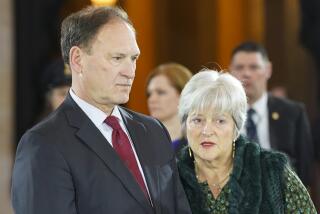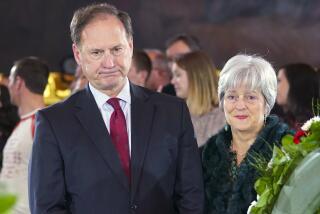Thomas marches to his own tune
Sixteen years after he turned the tables on Anita Hill by telling a Senate committee that he was the victim of a “high-tech lynching,” Supreme Court Justice Clarence Thomas remains a figure of fascination for journalists and amateur psychologists. The enigma that is Thomas the public persona is summed up in the title of a recent biography of the justice: “Supreme Discomfort: The Divided Soul of Clarence Thomas.”
Interesting as it may be to dissect Thomas’ life, his work is actually more interesting. It’s old news that Thomas is no jurisprudential clone of Justice Antonin Scalia. Venerate or vilify him, he’s his own man with his own principles, notably a willingness to reconsider earlier decisions that makes Scalia look like a patsy for precedent.
Thomas’ service on the court puts a positive spin on the line from “Me and Bobby McGee” that “freedom is just another word for nothing left to lose.” With little influence over his colleagues to squander, Thomas is free to tell them the truth that they are fudging the facts or the law in order to reach consensus.
Take Thomas’ concurring opinion in this week’s ruling in which the court, in an opinion by Chief Justice John G. Roberts Jr., held that an Alaska principal didn’t violate a student’s 1st Amendment rights by suspending him after he unfurled a banner with the ineffable message “BONG HiTS 4 JESUS” during a field trip.
The politically deft Roberts was able to cobble together a majority by not overruling Tinker vs. Des Moines School District, an Age of Aquarius decision proclaiming that schoolchildren don’t “shed their constitutional rights to freedom of speech or expression at the schoolhouse gate.” In that 1969 case, a more liberal court overturned the suspensions of teens and tweens who had worn black armbands to school to protest the Vietnam War.
Thomas joined the majority in the “bong banner” case, but wrote a characteristically distinctive concurring opinion. Where Roberts (and the dissenters) endeavored to calibrate how much protection the 1st Amendment affords to schoolchildren, Thomas relied on history to suggest that it doesn’t protect them at all.
“During the Colonial era,” Thomas pointed out, “private tutors offered the only educational opportunities for children, and teachers managed classrooms with an iron hand.” When public schools were established in the early 1800s, “no one doubted the government’s ability to educate and discipline children as private schools did. Like their private counterparts, early public schools were not places for freewheeling debates or exploration of competing ideas.” (So take off that armband protesting the War of 1812, Master Johnson.)
It’s easy to dismiss Thomas’ approach as “naïve historicism” unsuited to a living Constitution. But originalism is a respectable (if inadequate) approach to constitutional interpretation. It’s desirable that the Supreme Court include an unapologetic exponent of that technique.
Thomas’ real contribution in his opinion in the bong banner case isn’t his back-to-basics understanding of pedagogy; it’s his willingness to say that his colleagues in the majority, like Hans Christian Andersen’s emperor, are wearing no clothes.
Noting that the court had introduced various exceptions to the Tinker case’s celebration of student-speech rights, Thomas wrote: “Today, the court creates another exception. In doing so, we continue to distance ourselves from Tinker, but we neither overrule it nor offer an explanation of when it operates and when it does not.
“I am afraid,” he continued, “that our jurisprudence now says that students have a right to speak in schools except when they don’t -- a standard continuously developed through litigation against local schools and their administrators. In my view, petitioners could prevail for a much simpler reason: As originally understood, the Constitution does not afford students a right to free speech in public schools.”
I think Roberts’ approach didn’t go far enough to protect students’ speech rights; the kid with the bong banner should have won the case. But you can believe that and still recognize the acuity of Thomas’ critique of the muddled majority opinion. It’s not the first time he has lashed his colleagues for their dodgy, disingenuous arguments.
When the Supreme Court in 2004 punted a constitutional challenge to the phrase “under God” in the Pledge of Allegiance, deciding that the California atheist who sued his daughter’s school lacked standing to sue, Thomas wrote a tour de force opinion that must have made uncomfortable reading for his colleagues.
Thomas concluded 1) that Michael Newdow, the atheist parent, did have standing; 2) that the famously liberal U.S. 9th Circuit Court of Appeals had been correct to rule “under God” unconstitutional in light of Supreme Court decisions against prayer in public schools and at graduation ceremonies; but 3) that those landmark decisions were wrong even if one accepted the notion (which Thomas doesn’t) that states and public schools are covered by the 1st Amendment’s holding that “Congress shall make no law respecting an establishment of religion.”
At once erudite and exasperating, Thomas’ opinion in the Pledge case is, as they say, “outside the mainstream.” And a good thing too, for both the court and the country. One justice like Thomas on the court is enough -- but it’s not one too many.
Michael McGough is The Times’ senior editorial writer.
Send us your thoughts at [email protected].
More to Read
A cure for the common opinion
Get thought-provoking perspectives with our weekly newsletter.
You may occasionally receive promotional content from the Los Angeles Times.











